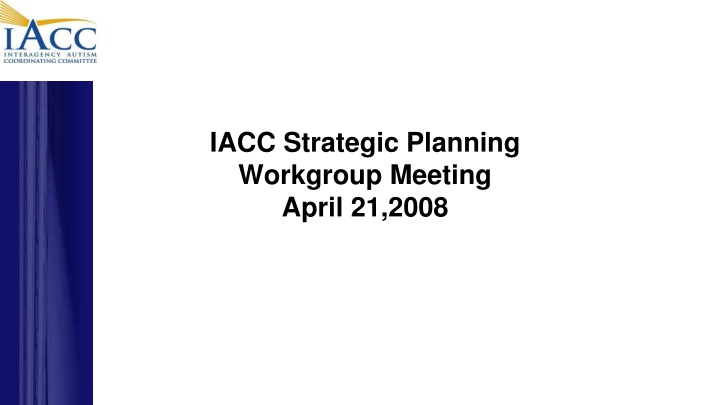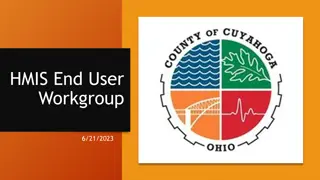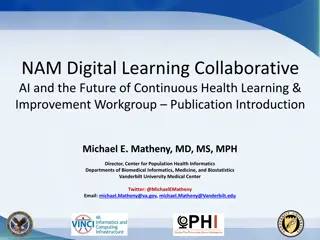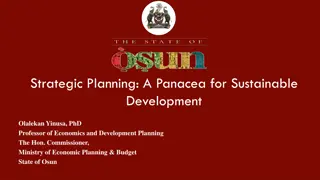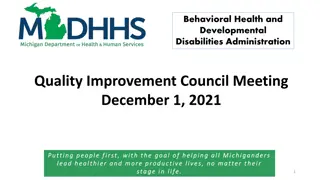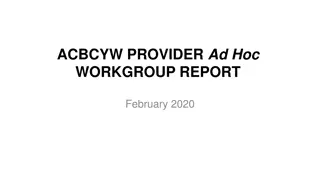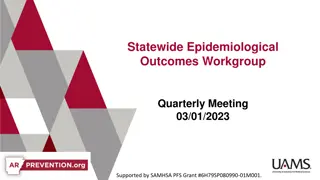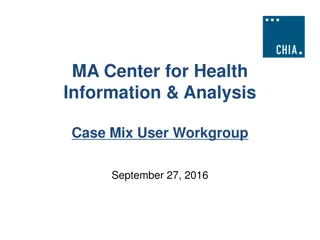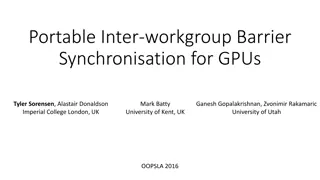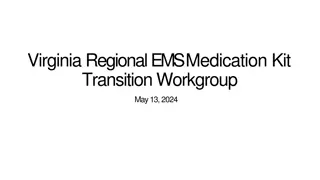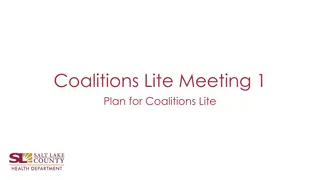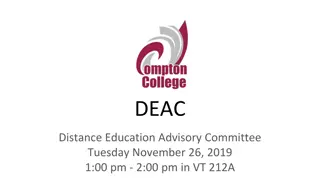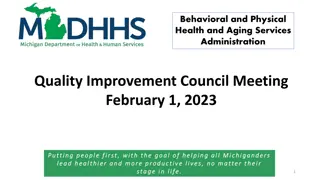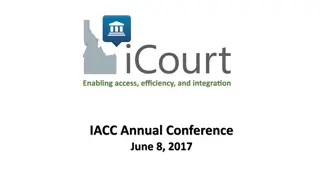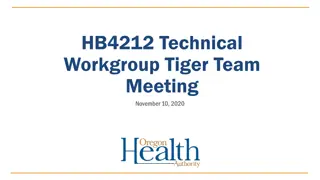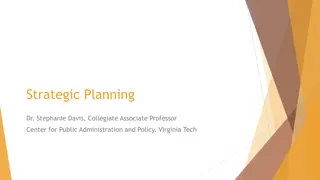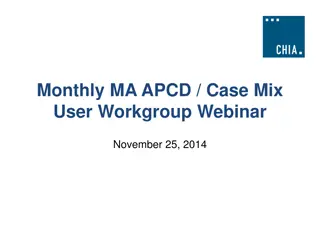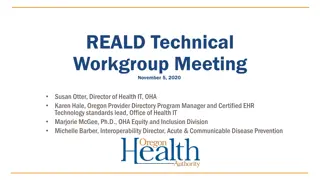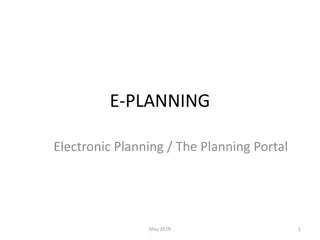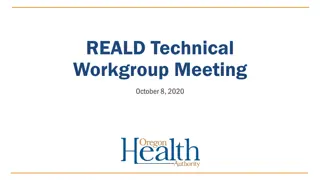IACC Strategic Planning Workgroup Meeting Overview
In-depth look at the IACC Strategic Planning Workgroup meeting held on April 21, 2008. It covers the structure, completed steps, workgroup roster, public participation, and values integral to the process.
Download Presentation

Please find below an Image/Link to download the presentation.
The content on the website is provided AS IS for your information and personal use only. It may not be sold, licensed, or shared on other websites without obtaining consent from the author.If you encounter any issues during the download, it is possible that the publisher has removed the file from their server.
You are allowed to download the files provided on this website for personal or commercial use, subject to the condition that they are used lawfully. All files are the property of their respective owners.
The content on the website is provided AS IS for your information and personal use only. It may not be sold, licensed, or shared on other websites without obtaining consent from the author.
E N D
Presentation Transcript
IACC Strategic Planning Workgroup Meeting April 21,2008
Structure for Strategic Plan IACC Strategic Planning (SP) Workgroup Scientific Workshops IACC SP Work Group Treatment Workshop Diagnosis Workshop Risk Factors Workshop Biology Workshop All involve Stakeholders NIMH Autism Team
Completed Steps Strategic Planning Process Approved by IACC-Nov - 07 Stakeholders RFI- Dec 07 - Jan 08 Four Scientific Workshops Held Jan 08 SP Workshop Meeting Feb 08 New SP Workgroup Formed by AICC March 08
SP WG Roster Steve E. Hyman, M.D. (chair) Harvard University David Amaral, Ph.D. University of California, Davis Peter Bell MBA Autism Speaks Mark F. Blaxill MBA Coalition for Safe Minds Judith Cooper, Ph.D. NIDCD Geraldine Dawson, Ph.D. Autism Speaks Steve Eiken, M.A. Thomson Healthcare Daniel Geschwind, M.D., Ph.D. UCLA Martha Herbert, M.D., Ph.D. Harvard Medical School Alice Kau, Ph.D. NICHD Catherine Lord, Ph.D. University of Michigan David Mandell, Sc.D. University of Pennsylvania Prisca Chen Marvin, J.D. Sam Odom, Ph.D. University of North Carolina Isaac Pessah, Ph.D. University of California, Davis Denise D. Resnisk SARRC Stephen Shore, Ed.D IACC Public Member V. Fan Tait, M.D. American Academy of Pediatrics Edwin Trevathan, M.D., MPH CDC Lucille Zeph, Ed. D. University of Maine Andrew Zimmerman, M.D. Kennedy Krieger Institute
Public Participation Public registrants could listen to the meeting via teleconference link and view slides on the Internet 198 registered 121 participated Average length of call = 229 minutes Two workgroup members and some IACC members participated virtually and had the capability to speak and be heard
Values Sense of Urgency We will focus on what steps we can take now to be responsive to the needs of individuals and families affected by ASD. Spirit of Collaboration We will treat others with respect, listen to diverse views with open minds, and foster discussions where participants can comfortable offer opposing opinions. Consumer focused We will focus on making a difference in the lives of people affected by ASD, including individuals with ASD, their families, medical practitioners, educators, and scientists.
Values Excellence We will pursue basic and clinical research of the highest quality to protect the safety and advance the best interest of those affected by ASD. Partnership in Action- We will value cross-disciplinary approaches, data sharing, teamwork, and partnerships with clearly defined roles and responsibility. Accountability We will develop SMART (specific, measurable, achievable, realistic, and time-bound) research objectives aligned with funding priorities and develop systems for evaluations and course corrections.
Framework for Initiatives I. WHEN should I be concerned about my child s development? (7) II. HOW can I understand what is happening to my child? (9) III. WHAT caused this to happen and can this be prevented? (7) IV. WHICH treatments will help my child? (9) V. WHERE can I turn for services? (4) VI. WHAT does the future hold? (5)
Goals for Workgroup Review the 2007 ASD research funding portfolio Prioritize research initiatives within the six question framework Discuss budgetary requirements of the strategic plan
NIH FY 2007 Autism Portfolio $127 million on autism grants, contracts, intramural research projects. Additional $3.9 million invested in National Database for Autism Research (NDAR) in FY07. NIH Autism Coordinating Committee (ACC) categorized diverse portfolio of research activities into five broad research areas with subcategories. Assigned each research activity and associated funding to one research area and subcategory based on this primary aims and objectives.
Research Areas and Corresponding Subcategories Biology Subcategories: Clinical Neuroscience, Basic Neuroscience, and Biological Systems Treatment Subcategories: Psychopharmacology, Biomedical, Behavioral/Psychosocial, Services Research, and Biomarkers for Treatment Response Diagnosis Subcategories: Instrument Development, Early Identification, Characterization, Incidence/Prevalence Risk Factors Subcategories: Genetics/Genomics, Environmental Influences and Gene x Environment Interplay, Mechanisms and Model Systems of Environmental Influences, and Psychosocial Other Subcategories: Research Resources (e.g., data systems, repositories of biomaterials), Education and Dissemination, and Other
FY 2007 NIH Autism Portfolio Total Autism Funding by Research Area and Subcategory
FY 2007 NIH Autism Portfolio Percentage of Total Autism Funding ($126,843,735) by Research Area Other 18% Biology 29% Risk Factors 22% Treatment 14% Diagnosis 17%
FY 2007 NIH Autism Portfolio Total Autism Funding* by organization and Research Area
FY 2007 Autism Portfolio Percentage of Total Autism Funding* ($160, 261,042) by Research Area Other 15% Biology 28% Risk Factors 24% Treatment 13% Diagnosis 20% *Note: Funding data reflect investments from NIH, CDC, DoD, and The Simons Foundation.
Prioritization of Initiatives 1. Discussed and developed criteria for prioritization 2. Prioritized within the six question domains to ensure coverage in each area 3. Each workgroup member selected highest priority initiates and distributed 100 points amongst choices
Prioritization of Initiatives 4. Results of workgroup scoring were tallied 5. Results of prioritization reviewed 6. Prioritized initiatives forwarded to IACC
SP WG Comments Emphasize to AICC that this is a work-in progress Would like to have a vision, mission and aspirational goals to provide overall structure for WG deliberations Took a middle-ground position that more work needs to be done but doing initial prioritization will move things forward
I. WHEN SHOULD I BE CONCERNED ABOUT MY CHILD S DEVELOPMENT? 515 (12) I.C.2. Identify Relevant Phenotypes that Relate to Etiology, Symptom Presentation, and Outcome 360 (10) I.A.2. Collaborative Development of Streamlined Screening/Diagnostic Approaches 359 (12) I.A.3. Screening and Diagnostic Instruments in Underrepresented Populations 276 (11) I.C.1. The Development of Improved Categorical and Dimensional Measures of ASD 234 (9) 1.8.2. Characterizing and Improving the Diagnostic Process in the Community 234 (8) I.A.1. Predictive Validity of Existing Screens in Community Setting 120 (3) 1.8.1. Evaluating Diagnostic Criteria/Approaches
II. HOW CAN I UNDERSTAND WHAT IS HAPPENING TO MY CHILD? 381 (10) II.A.3. Role of Immune and Infectious Factors in the Pathogenesis of Autism - Human and Animal Studies 333 (12) II.A.4. Postmortem Brain and Tissue Acquisition Initiative 297 (11) II.B.2. Developing Biomarkers for Autism 296 (9) II.A.1. Multidisciplinary Longitudinal Study of Infants with Autism Before Age Three 263 (9) II.A.2. Understanding Mechanisms of Neuroplasticity in Autism 220 (7) II.B.1. Gender Differences in the Biological Features of Autism 145 (5) II.B.3. Gene-based Phenotyping and Cognitive Neuroscience 108 (3) II.A.5. Identification of Large-Scale Neural Systems Whose Function is Altered in Pre-adolescent Autism 45 (2) II.B.4. New Paradigm for Clinical Genetic Evaluation and Subsequent Diagnosis
III. WHAT CAUSED THIS TO HAPPEN AND HOW THIS BE PREVENTED? 652 (17) III.B.3. Analysis of Mechanisms Underlying the Interplay of Genetic and Environmental Factors 373 (11) III.B.5. Develop Resources for Appropriate Control and Comparison Groups for Biological, Genetic and Other Studies of ASD 364 (14) III.B.2. Studies of Risk Factor Exposures From Pre-Conception to Early Postnatal Life 230 (8) III.B.4. Methods Development for Biologic Exposures I Biomarkers 208 (5) III.A.1. Large-scale Resource of Genomic Data on Autism Spectrum Disorders 148 (5) III.B.1. Risk Factor Studies in Other Special 124 (5) II.A.2. Informing the Genetics and Neurobiology of ASD Based on New Heritable Phenotypes Populations
IV. WHICH TREATMENTS WILL HELP MY CHILD? 455 (13) IV.A.1. Interventions for Older Children and Adults with ASD 313 (9) IV.B.2. Investigation of Efficacy and Safety of Commonly Used and Untested Treatments for ASD 285 (9) IV.A.2. Intervention and Prevention Approaches for Infants and Toddlers at Risk for Autism 252 (7) IV.B.4. Fast Track Mechanisms to Facilitate Translational Treatment Research 211 (6) IV.B.3. Animal Models and Cellular Systems for Developing Treatments for Autism 195 (9) IV.B.1. Role of Co-morbidity in ASD Treatment 140 (6) IV.A.3. Efficacy Trials for Comprehensive Intervention Models for Individual with ASD Across Ages 98 (4) IV.C.2. Novel Treatments of Core Symptoms 48 (2) IV.C.1. Identification of Biomarkers to Guide Treatment Selection and Evaluation of Treatment Outcome
V. WHERE CAN I TURN FOR SERVICES? 623 (15) V.A.2. Identify and Evaluate Models of Effective Dissemination of Evidence-Based Practices (EBP) into Community Programs 568 (13) V.A.3. Evaluation of Community-Based Intervention Models Informed by MultiDisciplinary Best Practices 454 (11) V.A.4. Cost-Outcome Studies of Intervention Models for People with Autism Spectrum Disorder (ASD) 445 (1 0) V.A.1. State of the States for Individuals with Autism Spectrum Disorder (ASD)
VI. WHAT DOES THE FUTURE HOLD? 487 (12) VI.A.2. Improved Identification and Characterization of Autism in Adulthood 453 (13) VI.C.2. Develop Resources to Coordinate Large PopulationBased ASD Initiatives (NDAR, CDC, NIH), IAN, State Registries) 436 (9) VI.A.1. Understanding Developmental Trajectories of Children and Families Affected by ASD 433 (9) VI.B.1. Enhance Tracking of ASD Prevalence in Children and Adolescents 291 (7) VI.C.1. Merging and Analyzing Administrative Databases Relevant to Diagnosis, Course, Interventions, and Long-Term Outcomes
Comments on Results Some individual initiatives scored noticeably higher than the others in the same question domain Overlap areas are instructive in that the highlight areas of general interest, e.g. biomarkers consolidation of initiatives can now be done Different opinions about scoring within question bins versus across question bins
Budgetary Requirements Treatment funding % was relatively smaller but other areas inform treatment such as diagnosis (early ID), or biological studies of mechanisms Don t starve one area to feed another Could reapportion within a funding domain, e.g. risk factors increase environment, decrease genetics
Budgetary Requirements Need more clinical trial infrastructure share with other development disorders? Efforts by Autism Speaks CTN and ATN noted Need for fast track mechanisms for high risk, high yield or n of 1 studies Some studies are more expensive to do than others so just looking at % can be misleading % in areas not as important as putting funds towards highest priorities
Usefulness of SP Identify priorities so that partnership between private and government groups will facilitate achieving the goals Develop RFAs or special emphasis panels Enable ASD initiatives to be funded that may be out of priority score order Attract excellent researchers to ASD research SP makes a strong case for building opportunities and stimulating quality research
Todays IACC Discussion IACC to review draft vision, mission and aspirational goal for strategic plan Review and discuss a draft template for strategic plan Approve further development of a SWOT (Strengths, Weaknesses, Opportunities, Threats) analysis of the comprehensive funding portfolio and 41 research initiatives
Next Steps Review input from Town Hall Meeting Develop short and long term objectives with measurable outcomes Refine prioritization and consolidate research initiatives Consider infrastructure/mechanism needs
Strategic Planning Process Process Phase Approximate Timing August 2007 B. Development of Draft SP Process September October C. IACC Meeting: Discussion & Adoption of SP Process l. November Development of Strategic Priorities D. SP Workgroup: Organize Workshops & Charge December E. RFI: Stakeholder Input on ASD Research Priorities F. Four Scientific Workshops to Generate Research Priorities January 2008
Strategic Planning Process Process Phase Approximate Timing February 2008 G. SP Workgroup: Preliminary Ranking of Overall Priorities ll. Plan H. Stakeholder Feedback on Ranked Priorities Development and Consolidation March I. IACC Meeting: Final Priority-Setting & Discussion of Budgetary Requirements for SP J. Begin Writing Strategic Plan April
Strategic Planning Process Process Phase Approximate Timing K. SP Workgroup: Consider Implementation Plans for Top Research Priorities April L. First Draft of Strategic Plan lll. Final Document Approval M. IACC Meeting: Discussion/Approval of Draft Strategic Plan May N. Formation of SP Implementation Workgroup O. Strategic Plan Completed and Sent to DHHS June H. Stakeholder Feedback on Final Plan
